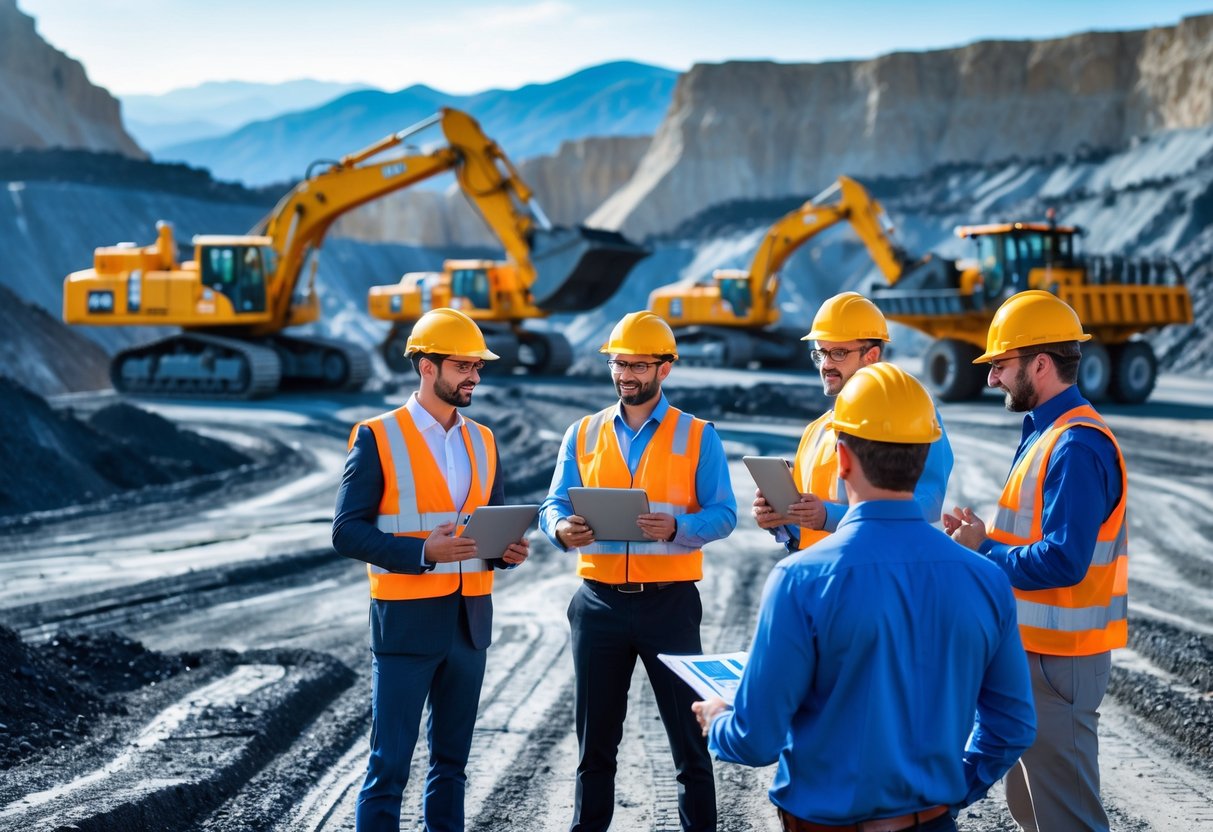Mining isn’t just about digging up rocks—it’s a real shot at uncovering business potential. As demand for metals, energy materials, and sustainable resources keeps rising, new ventures keep popping up in exploration, processing, and tech.
If you can spot where value meets real need, you can turn global demand shifts into profitable opportunities.

When I think about business opportunity mining, I see it as spotting supply chain gaps, trying out modern methods, and building partnerships that actually last. Reports like Four Golden Opportunities for the Mining Industry show that scaling up and making things more efficient can boost profits.
With the right approach, you can step into a field that rewards people who innovate and stick with it. Success in mining usually comes down to knowing the market, getting the right financing, and following the rules.
If you’re tired of chasing leads or wasting time, honestly, just message me on Whatsapp at +917303556188 for a quick consultation or to buy leads. Why work so hard when you can let someone else do the heavy lifting? Feel free to reach out—my clients know it’s just easier this way.
Key Takeaways
- Spot profitable opportunities by matching market demand with mining potential
- Build a strong foundation through smart planning and compliance
- Stay efficient and adapt to industry changes for steady growth
Understanding Business Opportunity Mining
I see business opportunity mining as hunting for ventures that actually make money in the mineral and metals world. You need to know how stuff like gold, copper, and nickel fit into global demand and production cycles.
It’s about knowing which resources people want, which companies are making them, and how the market sets the rules.
What Is Business Opportunity Mining?
For me, business opportunity mining means finding spots in the mining industry with real growth or investment potential. This could be in exploration, extraction, processing, or trading minerals and metals.
Mining props up industries like construction, energy, and tech. Copper and nickel, for example, are must-haves for electric vehicles and renewable energy.
I’m always checking out supply and demand trends. If demand jumps for something like lithium or nickel, new projects start to look pretty tempting.
Investors dig into company reports and feasibility studies to pick out viable ventures. To cut down on risk, I stick to regions with clear rules and decent environmental standards.
Responsible mining isn’t just good for the planet—it’s better for your returns in the long run.
Types of Minerals and Metals
I usually sort mining opportunities by the material. The main buckets are precious metals, base metals, and critical minerals.
| Category | Examples | Common Uses |
|---|---|---|
| Precious Metals | Gold, Silver | Jewelry, currency, electronics |
| Base Metals | Copper, Zinc | Construction, wiring, manufacturing |
| Critical Minerals | Nickel, Lithium | Batteries, renewable energy |
Gold and silver attract folks who want stability. Copper, zinc, and nickel drive industrial growth.
Forbes points out that demand for metals like nickel and lithium is pushing new exploration everywhere. I think this is a big deal—it ties mining straight to clean energy.
Key Players in the Mining Industry
I split the mining world into major companies and junior explorers. Big names like BHP and Anglo American run huge mines and control the supply chain.
Juniors are more like startups—taking risks on new discoveries for bigger rewards.
Majors offer stability; juniors give you a shot at big growth. It’s almost like comparing blue-chip stocks with up-and-coming tech companies.
If you want to keep up with trends and risks, reports like EY’s Top 10 risks and opportunities for mining and metals companies are worth a look.
Evaluating Mining Business Potential
I pay close attention to market conditions, test if a project makes sense financially and technically, and look for minerals or regions with real profit potential.
Each step helps me figure out if a mining venture is worth the hassle and how to dodge big risks before throwing in serious money.
Market Research and Trends
I always start with market demand for specific minerals. Tracking prices, supply gaps, and forecasts shows me where the action is.
Battery metals like lithium and nickel? Still hot, thanks to electric vehicles.
Trade data, government reports, and industry news help me spot market trends. Tools like Keys to a Successful Mine-site Valuation make it easier to estimate profits and costs.
I also check out regional mining activity to size up competition and infrastructure. Here’s how I jot down findings:
| Factor | Example Insight |
|---|---|
| Price Trend | Steady increase in copper prices |
| Supply Chain | Limited local smelters increase transport cost |
| Demand Driver | Growth in renewable energy projects |
This kind of research points me in the right direction.
Feasibility Study Essentials
Before diving in, I run a feasibility study to check if the project is realistic. I look at technical, financial, and environmental stuff.
A clear checklist like the one in the Feasibility Study Guide for Mining Projects keeps me on track.
I dig into ore quality, capital costs, and operational expenses. Then I crunch numbers like NPV and IRR to see if it’s worth it.
The Mining Feasibility Study: Key to Success says these figures can help attract investors and lock in funding.
I also check regulatory requirements and environmental impact. Getting this right early saves headaches later.
Identifying Profitable Mining Niches
I’m always looking for niche markets where demand is high but supply is tight. Specialty minerals—think rare earths or industrial sand—can pay off big.
Market analysis tools, like those in Evaluating the Economic Feasibility of Mining Ventures, help me see which resources are worth chasing.
Some regions even offer tax breaks or cheaper logistics. By mixing market data with feasibility results, I find the best bets for investment and growth.
If you want to skip the research and get straight to the good stuff, shoot me a Whatsapp at +917303556188. I’ve got leads ready, and honestly, it’s just easier to buy from someone who’s already done the homework. Feel free to reach out anytime.
Legal and Regulatory Considerations

I always keep an eye on how laws, permits, and environmental rules shape mining success. It’s about meeting standards, staying transparent, and building trust with regulators and locals.
Securing Permits and Licenses
Before I kick things off, I make sure to get the right permits and licenses from national and local agencies. These confirm that I’m following safety, environmental, and land use laws.
There are usually different permits for exploration, development, and production—each with its own set of hoops to jump through. Most places want an environmental assessment before you get the green light.
Mining Laws and Regulations Report 2026 says mining rights can come with ownership limits, transfer rules, and native title stuff.
To stay on track, I keep detailed records and make sure to renew or update everything on time. Here’s my quick permit checklist:
| Permit Type | Key Requirement | Renewal Period |
|---|---|---|
| Exploration License | Geological survey approval | 1–3 years |
| Mining Lease | Environmental clearance | 10–25 years |
| Export License | Trade compliance review | Annual |
Permits can slow you down, so I start early and talk to legal pros who know the local scene.
Understanding Compliance Requirements
Mining has to follow a maze of regulations—safety, labor, taxes, and environmental rules. I make sure my operations match both national laws and international standards, like those in Regulatory Compliance in Mining Industry.
I do regular audits to make sure reporting and tax stuff is squared away. Laws change fast, so I keep tabs on updates.
Key compliance areas:
- Environmental monitoring and waste management
- Worker health and safety
- Transparent financial reporting
- Anti-corruption and ethical conduct
Mess up here and you risk fines or losing your license. I use compliance management systems to keep everything organized.
Community and Environmental Engagement
Mining impacts local people and the environment, so I talk to stakeholders early. I use advice like that in Mining and Water: A Perspective on Legal and Regulatory Risks to stay accountable.
I hold public meetings, share info, and listen to concerns. This helps me keep a social license to operate and avoid drama.
For the environment, I handle water use, emissions, and land restoration. I use monitoring plans to track impacts and tweak as needed.
Sticking to standards and working with the community keeps projects stable and shows you’re running a responsible operation.
Building a Successful Mining Business

When I set up a mining operation, I focus on three things: planning, leadership, and technical know-how. A solid business plan keeps investments and operations on track.
A good team—managers, geologists, and engineers—makes sure things run smoothly and safely.
Developing a Robust Business Plan
I always start with a detailed business plan that lays out the scope, goals, and money needed for the project. It covers market analysis, resource estimates, and operational strategies.
I check mineral demand, price trends, and the legal climate in the region. The 2025 mining business plan framework suggests adding funding asks and realistic financial forecasts.
I also build in risk management for things like price swings or permit delays. Here’s how I keep my numbers straight:
| Category | Example Estimate |
|---|---|
| Startup Capital | $500,000–$5 million |
| Break-even Period | 2–5 years |
| Expected ROI | 10–20% annually |
This approach helps me pitch clearly to investors and lenders.
But honestly, if all this sounds like too much, why not just get in touch with me on Whatsapp at +917303556188? I’ve got leads ready, and you can skip all the hassle. Feel free to contact me—I’ll save you time and probably a few headaches too.
Assembling a Skilled Management Team
I always try to put together a management team that covers finance, operations, safety, and compliance. Each person gets clear responsibilities and goals—otherwise, things get messy fast.
- Operations Manager: Handles production and logistics.
- Finance Officer: Takes care of budgets, cost control, and getting funding.
- Compliance Lead: Looks after permits and environmental reporting.
Honestly, experienced managers save a ton of headaches and money, especially in the early days. I like to hire folks with backgrounds in industrial projects or natural resources—they just get the chaos of mining schedules and all the gear you have to buy.
I keep everyone on the same page with regular meetings and open reporting. If you want to skip the trial and error, feel free to contact me on WhatsApp for lead buying or a quick consult: +917303556188.
Role of Geologists and Engineers
Geologists are my go-to for finding, evaluating, and keeping tabs on mineral deposits. They dig into mapping, sampling, and drilling data to estimate reserves and cut down exploration risks.
Engineers? They design how we’ll actually get stuff out of the ground, pick the right machines, and make sure everything stays safe. These days, they’re also using automation and predictive maintenance—makes a huge difference.
I like to pair geologists and engineers on site visits. It’s a good way to balance science with what’s actually doable. That teamwork really bumps up efficiency and safety, and it’s something a lot of mining startup guides recommend.
If you’d rather not stress about hiring or assembling teams yourself, just ping me on WhatsApp. I’ve got leads and advice ready.
Financing and Investment Strategies

I spend a lot of time making sure I’ve got the right mix of capital and a handle on financial risks. It’s the only way to keep a mining venture stable—and, honestly, to sleep at night.
I look at all the funding options, work on building investor confidence, and keep my financial projections sharp enough to handle market curveballs.
Capital Requirements and Funding Sources
Mining eats up a lot of cash upfront—exploration, equipment, permits, you name it. I always start by figuring out total costs: development, running the place, and even closing it down someday.
Once I know the numbers, I look for outside funding. Here’s where I usually go:
| Funding Source | Description | Key Advantage |
|---|---|---|
| Equity Financing | Sell shares in the business | Shares risk with investors |
| Debt Financing | Borrow from banks or lenders | Keep full ownership |
| Joint Ventures | Team up with another company | Share costs and know-how |
| Government Grants | Public funds for green projects | Less pressure to repay |
Sometimes I use streaming or royalty deals—investors put up money and get a cut of future output. It keeps cash flowing and gives me some breathing room.
If you’re tired of chasing funding, why not let me help? I’ve got investor leads and strategies—just WhatsApp me at +917303556188.
Attracting Investors and Venture Capital
Investors want proof, not promises. I always back up my pitch with hard data: mineral reserves, extraction costs, projected returns.
I make a point of highlighting what makes my project stand out—location, resource quality, or some tech edge. Networking with folks who understand mining cycles helps a lot.
I keep communication open and send regular updates. Platforms like MiningWorld say that clear value and risk strategies make investors more likely to bite.
If you want intros to serious investors or help making your pitch, just reach out. Don’t waste months cold-calling—WhatsApp me and get real leads.
Financial Projections and Risk Management
I always run the numbers—capital costs, operating expenses, expected revenue. I use commodity forecasts and test what happens if prices drop or projects stall.
Risk management isn’t a one-time thing. I spread funding sources, hedge against price swings, and keep tabs on regulations. A contingency fund is my safety net for the unexpected.
Here are the key metrics I track:
| Metric | Target | Purpose |
|---|---|---|
| Return on Investment | >15% | Shows if it’s worth it |
| Debt-to-Equity Ratio | <1 | Keeps financing balanced |
| Operating Margin | >20% | Measures cost efficiency |
If spreadsheets and risk models aren’t your thing, I can hand over ready-to-go financial leads or advise on what works. Save yourself the headache—just message me.
Launching and Operating Mining Ventures
My focus is always on building mining operations that hit safety, environmental, and financial marks. Setting up right from the start, keeping an eye on performance, and making smart reinvestment choices—that’s how you get long-term results.
Setting Up Mining Operations
First thing, I lock down permits, land rights, and financing. I check geological data to make sure there’s actually something worth digging up and pick extraction methods that fit the mineral.
I put money into solid equipment—excavators, drills, screening machines. Everything’s got to meet safety and environmental standards. Startup costs can run from $500,000 to several million, depending on how big you want to go.
I hire trained operators and safety people early on. A clear structure with everyone knowing their job keeps things safe and smooth.
| Key Setup Steps | Purpose |
|---|---|
| Land acquisition | Secure rights and access |
| Equipment purchase | Make extraction possible |
| Regulatory compliance | Avoid fines and headaches |
| Staff recruitment | Build a skilled, safe team |
If you want a shortcut to reliable suppliers or trained staff, I’ve got leads. Contact me—don’t reinvent the wheel.
Operational Best Practices
I keep output steady by focusing on safety, maintenance, and real-time monitoring. Regular checks and predictive maintenance keep machines running.
I use digital tools to track production and environmental data. Compliance and safety come first—I train everyone on emergency procedures and equipment handling.
I set weekly production targets and check performance often. Simple dashboards for energy, output, and downtime help me spot problems fast.
If you want to skip the learning curve, I can connect you with proven operators and systems. Just message me and save yourself the hassle.
Scaling and Diversifying Mining Businesses
Once things run smoothly, I look for ways to expand or diversify. I put profits back into exploring new deposits or automation tech that boosts yield.
Joint ventures or partnerships help share costs and open up new markets. Scaling takes both cash and experienced management—no way around it.
Diversifying into processing or logistics can steady income when commodity prices bounce around. I keep an eye on market trends and adjust based on demand.
If you want leads on expansion partners or new markets, just reach out. Why struggle alone?
Frequently Asked Questions
Here are some practical insights about mining in 2025—tech trends, market shifts, top companies, and job opportunities. I also use tools like SWOT analysis to help mining firms make smarter moves.
What are the latest trends shaping the mining industry in 2025?
Honestly, it’s all about automation, AI, and renewables. Companies use digital twins, IoT sensors, and even satellites to watch their sites. Urban mining and circular economy ideas are catching on, too. The 2025 mining guide has some good examples.
How has the global mining market size changed in recent years?
I’ve seen steady growth, mostly thanks to demand for critical minerals like lithium, nickel, and copper. Electric vehicles and green energy keep pushing up the need for these resources. More companies are investing in sustainable mining as they modernize.
What are the key findings from the latest PwC mining report?
The PwC mining outlook points to lots of mergers and asset diversification. ESG performance and digital upgrades are now front and center. EY’s survey says the same thing—risks and opportunities are changing fast.
Which mining businesses are considered the most profitable in the current market?
Right now, companies focused on battery metals—lithium, cobalt, copper—are winning. Those who invest in automation and low-carbon operations see better margins. Even smaller ventures in mineral recycling can do well with lower startup costs, according to Profitable Venture.
What are the highest paying jobs in the mining sector today?
Mine managers, drilling engineers, and geotechnical specialists are at the top for salaries. Jobs in automation, data analytics, and environmental compliance are growing fast. If you’ve got technical or digital skills, you’ll definitely earn more.
If you’re ready to buy leads, get advice, or just want to talk mining, don’t waste time—feel free to contact me on WhatsApp at +917303556188. Why work harder than you have to?
How can a SWOT analysis benefit companies in the mining industry?
I use SWOT analysis to spot strengths, weaknesses, opportunities, and threats before diving into big decisions. It’s honestly a lifesaver for figuring out market risks or whether that shiny new tech is actually worth the money.
Trying to balance sustainability and profit? SWOT helps you see if your green goals actually line up with your bottom line. If you’re new to mining, the How to Start a Mining Business 2025 Guide says you shouldn’t even think about skipping this step.
Let’s be real—why stress over all this yourself? If you want leads or need a bit of consultation, just ping me on WhatsApp at +917303556188. Feel free to contact anytime; honestly, it’s easier to let me handle it so you can focus on what matters.



